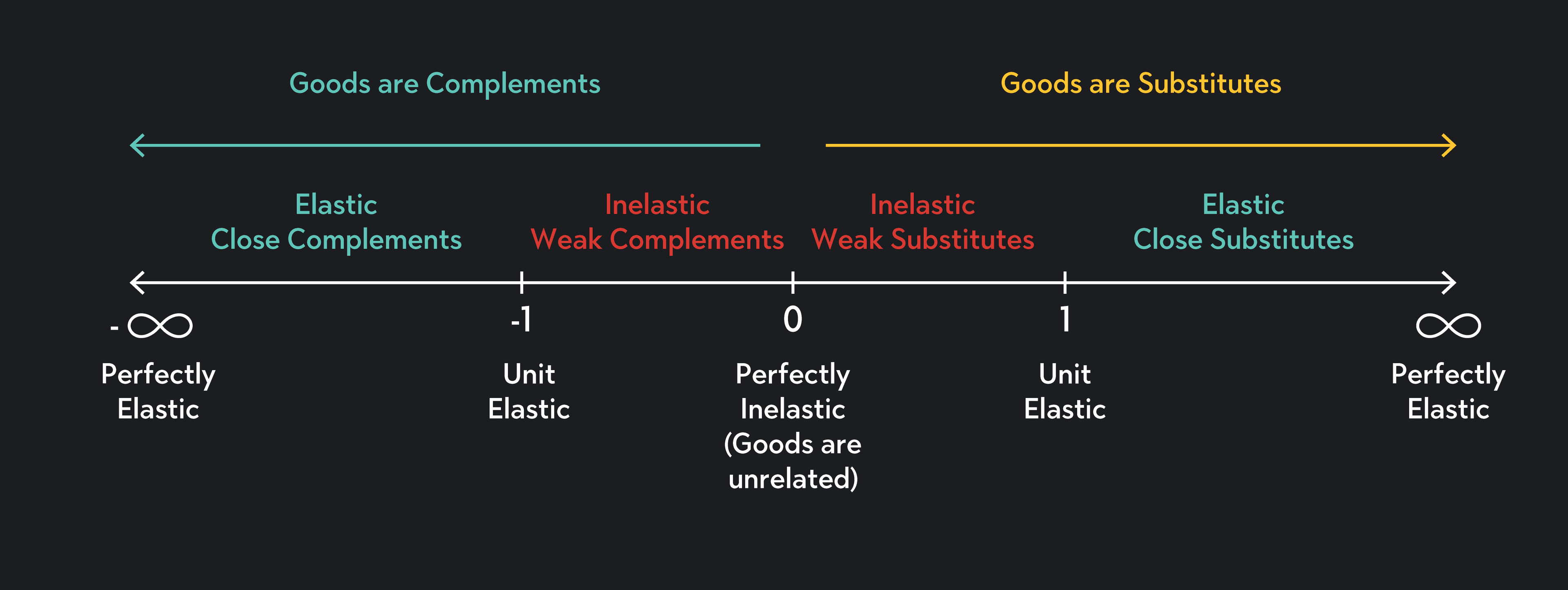
Economics
Understanding the Supply Curve & How It Works
Learn about what a supply curve is, how a supply curve works, examples, and a quick overview of the law of demand and supply.
Alejandro Diaz Herrera
Subject Matter Expert

Economics
04.23.2022 • 5 min read
Subject Matter Expert
Here’s an overview of cross price elasticity of demand, its definition, how it works, the difference with income elasticity of demand, and more.
In This Article
Ever wonder how a change in the price of Coca-Cola affects demand for Pepsi? Or how a price rise of Smucker’s jelly affects demand for Skippy’s peanut butter? Cross price elasticity of demand helps you answer such questions.
Cross price elasticity of demand (XED) is a measure of how demand for one good changes in response to a change in the price of another good. The other good might be a related good such as a substitute—a good that consumers buy in place of another good—or a complement—a good that’s consumed together with another good. It could also be a completely unrelated good, in which case, the cross-price elasticity will be zero.
To measure the cross price elasticity of demand, divide the percentage change in quantity demanded for one good by the percentage change in the price of a second good.
Cross price elasticity of demand equals:
Δ is the change in the quantity demanded of Good A. To find the change subtract, the initial quantity demanded from the new quantity demanded.
is the initial quantity demanded for Good A.
Δ is the change in price of Good B. You can find this change by subtracting the initial price from the new price.
is the initial price of Good B.
As an example, say you want to know how a change in the price of hot dogs affects demand for hot dog buns. You observe that when the price of hot dogs increases from $6.50 to $7.02, the sale of hot dog buns falls from 1000 units to 910 units. Using the formula above, you can calculate the cross price elasticity as:
This cross price elasticity of demand tells us that an 8% price increase for hot dogs is associated with a 9% decrease in demand for hot dog buns. The fact that the cross price elasticity is greater than 1 in absolute terms tells you that the percent change in the quantity demanded is larger than the percent change in the price of hot dogs.
Cross price elasticity of demand can be negative, positive, or zero.
The cross price elasticity of demand will be negative when two goods are complements.
Complementary products are goods that are consumed together. If the price of one good goes down, demand for its complement will increase and vice versa. The quantity change in one good and the price change in the second good will always move in opposite directions for complements. This is what makes the cross price elasticity negative.
As an example, think of peanut butter and jelly. Because these goods are frequently consumed together, if the price of jelly falls, consumer demand for peanut butter will increase. If the price of jelly goes up, consumer demand for peanut butter will decrease.

Cross price elasticity of demand will be positive when two goods are substitutes.
Substitute goods are goods used to satisfy the same demand. If the price of a good goes down, demand for its substitute will decrease and vice versa. In this way, the quantity change and the price change will always move in the same direction for substitutes. This is what makes the cross price elasticity positive.
As an example, think of Pepsi and Coca-cola. If you assume the two brands of soda are substitutes, if the price of Coke falls, consumer demand for Pepsi will fall because more consumers will choose to buy Coke over Pepsi. If the price of Coke increases, demand for Pepsi will increase as consumers shift away from Coke and start buying more Pepsi.
Cross price elasticity of demand will be zero when two goods are unrelated.
When two goods are unrelated, the price of one good should have no effect on demand for the other. This is why the cross price elasticity of two unrelated goods will be zero.
Elasticities can take on any value.
When the cross price elasticity coefficient is less than -1 or greater than 1, the cross price elasticity is elastic. In the case of two substitutes, this means that the two goods are strong substitutes where one good can easily replace the other. In the case of complements, this means the two goods are strong complements that are frequently purchased together.
When cross price elasticity is between -1 and 0 for complementary goods and between 0 and 1 for substitute goods, the cross price elasticity is inelastic. This indicates that the two goods are either weak complements or weak substitutes.
The figure below summarizes what you need to know to interpret the cross price elasticity of demand. Remember, when the cross price elasticity is positive the two goods are substitutes. When the value is negative, the two goods are complements, and when the value is zero, the two goods are unrelated.

In general, elasticity measures the responsiveness of one thing to a change in another.
Cross price elasticity of demand is just one type of elasticity you’ll learn about in economics.
Other types of elasticity you might come across in your economics courses are:
Price Elasticity of Demand - This measures how the quantity demanded of a good changes in response to a change in its price. Unlike cross price elasticity, price elasticity of demand relates quantity demanded for a good to its own price rather than the price of another good.
Price Elasticity of Supply - This measures how the quantity supplied for a product changes in response to a change in its price.
Income Elasticity of Demand - This measures how quantity demanded for a good changes in response to changes in the income of consumers who buy the good.
| TYPE OF ELASTICITY | RESPONDS TO CHANGE IN: | MEASURES: |
| Cross price elasticity of demand | Price of another good | How demand for one good changes |
| Price elasticity of demand | Price of product demanded | How quantity demanded for a good changed |
| Price elasticity of supply | Price of product supplied | How quantity supplied for a good changed |
| Income elasticity of demand | Income of consumers who buy the good | How quantity demanded for a good changed |
Check your understanding of cross price elasticity by answering these three questions.
The price of Colgate toothpaste falls from $4.50 to $4.32. As a result, sales of Aquafresh toothpaste decrease from 20,000 units to 19,000 units. Without doing the calculation, do you expect the cross price elasticity of demand for Aquafresh to be positive or negative?
Calculate the cross price elasticity of demand for Aquafresh toothpaste using the information from Question 1.
If honey and tea are weak complements, the cross price elasticity of demand for honey with respect to changes in the price of tea should be:
a) Less than -1
b) Between -1 and 0
c) Between 0 and 1
d) Greater than 1
A positive cross elasticity of demand should be the result, since Aquafresh and Colgate toothpaste are substitutes.
B. Two goods that are weak complements should have cross price elasticity of demand that is between -1 and 0.
Related: The Definition of Elasticity of Demand
Outlier (from the co-founder of MasterClass) has brought together some of the world's best instructors, game designers, and filmmakers to create the future of online college.
Check out these related courses:

Economics
Learn about what a supply curve is, how a supply curve works, examples, and a quick overview of the law of demand and supply.
Subject Matter Expert

Economics
This article gives a quick overview of perfect competition in microeconomics with examples.
Subject Matter Expert

Economics
This article is a comprehensive guide on the causes for a demand curve to change. Included are five common demand shifter examples.
Subject Matter Expert